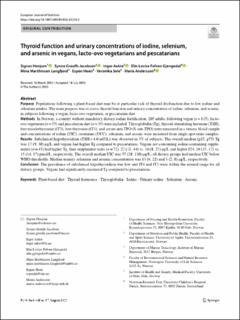| dc.description.abstract | Purpose Populations following a plant-based diet may be at particular risk of thyroid dysfunction due to low iodine and
selenium intakes. The main purpose was to assess thyroid function and urinary concentration of iodine, selenium, and arsenic,
in subjects following a vegan, lacto-ovo vegetarian, or pescatarian diet.
Methods In Norway, a country without mandatory dietary iodine fortification, 205 adults, following vegan (n = 115), lacto-
ovo vegetarian (n = 55) and pescatarian diet (n = 35) were included. Thyroglobulin (Tg), thyroid-stimulating hormone (TSH),
free triiodothyronine (fT3), free thyroxine (fT4), and serum anti-TPO (S-anti-TPO) were measured in a venous blood sample
and concentrations of iodine (UIC), creatinine (UCC), selenium, and arsenic were measured from single spot urine samples.
Results Subclinical hypothyroidism (TSH > 4.0 mU/L) was observed in 3% of subjects. The overall median (p25, p75) Tg
was 17 (9, 30) μg/L and vegans had higher Tg compared to pescatarians. Vegans not consuming iodine-containing supple-
ments (n = 43) had higher Tg, than supplement users (n = 72), 27 (11, 44) vs. 16 (8, 25) μg/L and higher fT4, 16 (15, 17) vs.
15 (14, 17) pmol/L, respectively. The overall median UIC was 57 (28, 130) μg/L, all dietary groups had median UIC below
WHO thresholds. Median urinary selenium and arsenic concentration was 13 (6, 22) and 3 (2, 8) μg/L, respectively.
Conclusion The prevalence of subclinical hypothyroidism was low and fT4 and fT3 were within the normal range for all
dietary groups. Vegans had significantly increased Tg compared to pescatarians. | en_US |

